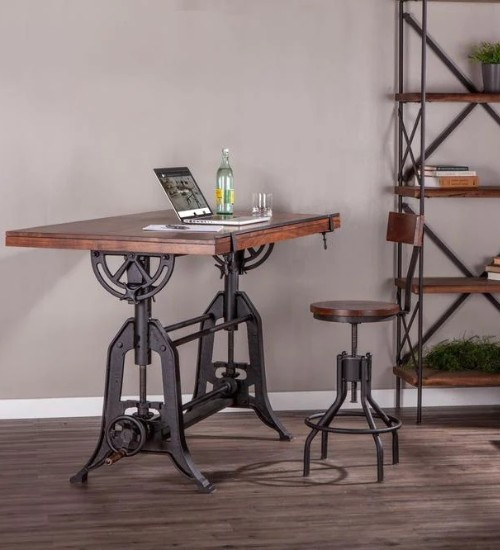Trend Alert! Crank Tables and Desks
Posted by Zin Home on 3rd Jan 2023
Incorparete Industrial Style Crank Tables in Your Home Decor
Crank tables have become increasingly popular in recent years, and it's easy to see why. These tables bring together industrial modern and rustic design elements, and their adjustable height allows them to be used for a variety of purposes, such as dining, desks, gathering tables, bar tables, and more. This article will provide an overview of crank tables, including materials, construction, styles, and maintenance.
What are Crank Tables Made Of?
Our crank tables are made of two main materials: iron and solid wood. Iron is used to create a sturdy, tip-resistant base, while solid wood is employed to create rustic table tops. The iron we use is reclaimed, and there are two main categories: cast iron and forged iron. Cast iron is a more cost-effective option that is used more commonly for pieces that undergo less stress, such as chairs. While not as strong as forged iron, cast iron is still rated to last a lifetime with proper care, and it is preferred for more complex pieces because it is easier to pour into a cast than to forge into shape. Forged iron, on the other hand, is used for pieces that require both strength and durability, as it can retain its shape while withstanding immense pressure. However, the process of forging iron is more involved, so forged iron products tend to be more expensive.
For our table tops, we use several different species of solid wood: Acacia, Mango, and Teak. Acacia wood is found growing in forests around the world and is known for its durability and resistance to water and rot. Teak wood, an age-old favorite, is known for its decay resistance and unique combination of being lightweight yet durable. It is also rare, with old-growth Teak trees being protected, so the Teak wood we use is sourced from old buildings and ships.
How Does The Crank Function?
Of course, the key feature of crank tables is the hand crank, which is used to adjust the table's height. It is important to note that some force is required to move the table, but it should not require a lot of effort. If you find yourself applying a lot of pressure to adjust the height, check for wingnuts along the shaft, which can be tightened to hold the table in place at its current height. If the wingnuts are tightened while adjusting the height, it can cause the threading on the shafts to be off-set and result in a tilted table top. In this case, the table will need to be taken apart and the shafts reset.
It is also worth noting that each crank table is intended to have rustic elements, such as a rough, textured table top that reflects the natural characteristics of the wood. While this is not considered a defect, it can be a concern for those who prefer a smoother surface. In this case, we recommend using a protective coating to preserve the table's rustic look while providing a smoother surface for daily use.
How to Maintain Crank Tables?
When it comes to maintenance, the most important thing is to keep the crank mechanism clean and lubricated. This will ensure that it functions smoothly and prolong its lifespan. It is also important to regularly check for and tighten any loose bolts, as well as protect the wood with a good quality wood oil or sealer.
In terms of styles, crank tables come in a variety of shapes, sizes, and finishes to suit different needs and tastes. Some popular options include vintage-inspired tables with weathered finishes, industrial loft tables with drafting desk functionality, and mid-century modern tables with sleek, clean lines. No matter what style you choose, a crank table is a versatile and stylish addition to any home or office.
